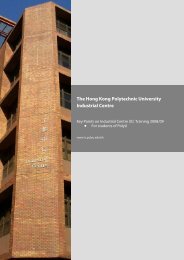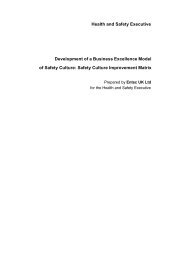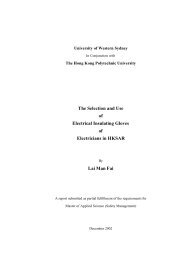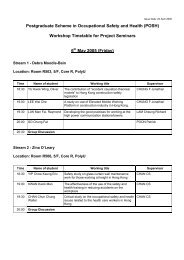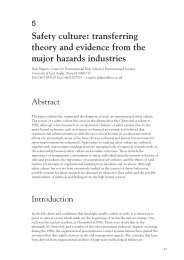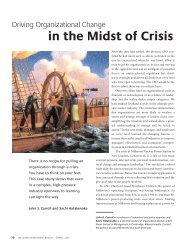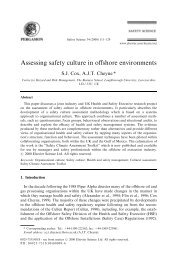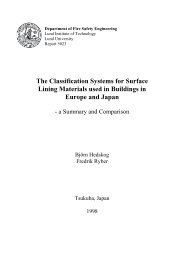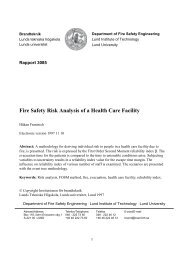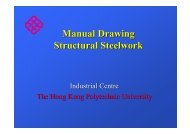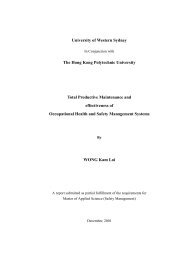An assessment of risk and safety in civil aviation - Industrial Centre
An assessment of risk and safety in civil aviation - Industrial Centre
An assessment of risk and safety in civil aviation - Industrial Centre
You also want an ePaper? Increase the reach of your titles
YUMPU automatically turns print PDFs into web optimized ePapers that Google loves.
48 M. Janic / Journal <strong>of</strong> Air Transport Management 6 (2000) 43}50<br />
Fig. 2. Dependence <strong>of</strong> the average fatal accident rate on the number <strong>of</strong> airl<strong>in</strong>e #ights (1970}1997).<br />
Source <strong>of</strong> data: Internet (1998).<br />
The <strong>risk</strong>s associated with di!erent aircraft types<br />
are found by regress<strong>in</strong>g the number <strong>of</strong> accidents per<br />
aircraft type AR <br />
, on the number <strong>of</strong> #ights per aircraft<br />
type F <br />
, <strong>and</strong> the average age <strong>of</strong> particular<br />
aircraft type E <br />
. The data cover the period from the<br />
entry <strong>in</strong>to service <strong>of</strong> a particular aircraft type to 1992.<br />
The aircraft types covered are Fokker F28, Fokker<br />
F70/F100; Airbus A300, A310, A320; Lockheed L1011;<br />
British Aerospace BAe146; Boe<strong>in</strong>g B727, B737-1/200,<br />
B737-3/4/500, B747, B757, B767; McDonnell Douglas<br />
DC9, MD80 (Internet, 1998; Walder, 1991). The equation<br />
used is<br />
AR "1.206 #1.743F #0.900E <br />
(0.692) (6.355) (3.887),<br />
R"0.929; F"84.640; D="1.823; N"16. (4)<br />
The overall equation <strong>and</strong> <strong>in</strong>dividual coe$cients are signi"cant<br />
at the 1% level. The equation may o!er an<br />
explanation <strong>of</strong> the past but this <strong>in</strong>formation was not<br />
available <strong>in</strong> advance to those <strong>in</strong>volved. The equation<br />
<strong>in</strong>dicates that the cause <strong>of</strong> air accidents could stem<br />
from the existence <strong>of</strong> geriatric factors that escalated<br />
faster as aircraft are utilized more <strong>and</strong> age. Because<br />
the operational hypothesis is that aircraft accidents happen<br />
as r<strong>and</strong>om events, the equation does not imply that<br />
more used <strong>and</strong> older aircraft have been less safe. It<br />
<strong>in</strong>dicates that the <strong>risk</strong> <strong>of</strong> travel<strong>in</strong>g <strong>in</strong> these aircraft is<br />
higher.<br />
5.2. Probabilistic <strong>assessment</strong><br />
The probabilistic <strong>assessment</strong> <strong>of</strong> accidents uses<br />
a sample <strong>of</strong> 259 accidents over the period 1965}1998. The<br />
distribution <strong>of</strong> time <strong>in</strong>tervals between these events is<br />
shown <strong>in</strong> Fig. 3. A simple calculation provides an estimate<br />
<strong>of</strong> the average accident rate: λ7.818 accidents per<br />
year or λ0.020 accidents per day. <strong>An</strong> analysis <strong>of</strong> the<br />
time <strong>in</strong>tervals between accidents, <strong>in</strong>dependent <strong>of</strong> aircraft<br />
type, <strong>in</strong>dicates they have been <strong>in</strong>dependent <strong>and</strong> exponentially<br />
distributed (a χ test con"rms the hypothesis<br />
match<strong>in</strong>g the empirical <strong>and</strong> theoretical data, <strong>An</strong>g <strong>and</strong><br />
Tang, 1975). This o!ers con"rmation that the observed<br />
pattern <strong>of</strong> accidents can be treated as Poisson process.<br />
Us<strong>in</strong>g the exponential distribution seen <strong>in</strong> Fig. 3, it is<br />
possible to assess the probability <strong>of</strong> an occurrence <strong>of</strong> an<br />
air accident. If there is unlikely to be any improvement <strong>in</strong><br />
<strong>safety</strong> features then this distribution can be used for<br />
assess<strong>in</strong>g the probability <strong>of</strong> future events. Fig. 4 illustrates<br />
the probability <strong>of</strong> the occurrence <strong>of</strong> at least one air<br />
accident per period t. This probability rises over time<br />
until the event. For example, the probability <strong>of</strong> at least<br />
one accident by the follow<strong>in</strong>g day from now is about 0.02,<br />
by next month 0.45, by six months 0.97, <strong>and</strong> by next year<br />
0.999.<br />
5.3. Assessment <strong>of</strong> deaths <strong>and</strong> <strong>in</strong>juries<br />
To complete the analysis <strong>of</strong> past accidents, the distributions<br />
<strong>of</strong> air accidents, fatalities <strong>and</strong> survivors per aircraft<br />
category can be separated. Aircraft can be treated as<br />
turbojets, turbo-props <strong>and</strong> piston-eng<strong>in</strong>e; see Table 2.<br />
The largest number <strong>of</strong> accidents <strong>in</strong>volved turbo-prop<br />
aircraft but the greatest number <strong>of</strong> people <strong>in</strong>volved <strong>in</strong><br />
The accidents <strong>in</strong>volved aircraft types, Boe<strong>in</strong>g B727, B737, B747,<br />
B757, B767, B777 (no event); MD80, DC10, MD11; Lockheed L1011,<br />
Airbus A300, A310, A320, A330 (no events), A340 (no events); Fokker<br />
F28, F100; British Aerospace BAe 146; Embraer EMB-110 B<strong>and</strong>eirante,<br />
EMB-120 Brasilia; Dorrnier 228; <strong>and</strong> Saab 340.



